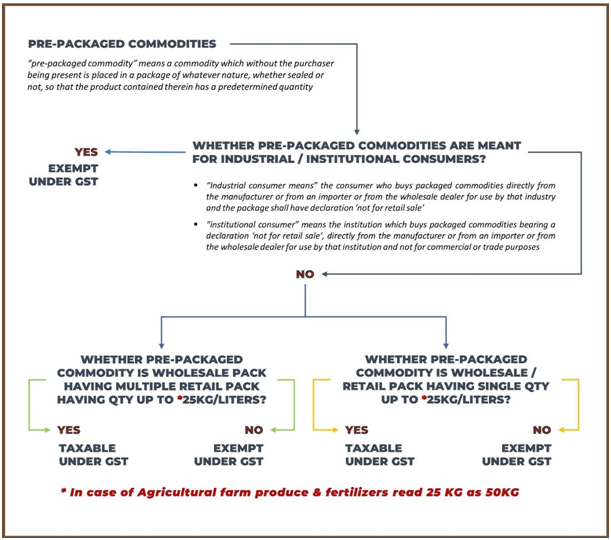GST council with an intention to tax the unbranded pre-packaged food items such as curd, dried leguminous vegetables, wheat/meslin flour, jaggery, rice, puffed rice, organic foods, etc has amended the rate and exemption notifications, wherein the condition of a product to be 'branded' for attracting taxability, has now been replaced with the condition of the product to be 'pre-packaged & labelled' as per the Legal Metrology Act, 2009 ('the LMA')
Further, the CBIC has also come up with FAQs in order to clarify certain underlying issues in the above subject matter such as the applicability of GST in terms of LMA, taxability of wholesale packages, and at what stage tax to be levied, etc.
Accordingly, understanding the applicability of declarations on the specified pre-packaged commodities as per the LMA becomes pivotal for understanding the taxability under GST. In this backdrop, we have tried to summarize the applicability of required declarations along with the exceptions under the LMA law, in both words as well as in a flow chart for a better understanding:

Applicability of LMA & GST
As per our understanding, GST would be levied on specified commodities having the following two attributes:
- It is pre-packaged: and
- It is required to bear declarations under the provisions of LMA and rules made thereunder However, LMA provides for the following exceptions to which the provisions of LMA shall not apply:
a. Commodities other than agricultural produce, where they are pre-packaged in a package of quantity more than 25Kgs/Litres
b. Commodities of agriculture produce fertilizers where they are pre-packaged in a package of quantity more than 50Kgs
c. The package is sold by weight or measure and amounts to less than 10 ml or 10 gm
d. Commodities which are sold in loose even if the quantity of the same is lower than the above limits
e. Irrespective of the quantity of the commodity, the package is meant for industrial/institutional consumers for their own use
Applicability of LMA & GST [Flowchart]

In connection to the above, the food industry at large might have a lot of concerns in implementing the said changes. We have tried to capture some of the practical issues that might crop up:
1. Agricultural farm produce
There is an exemption based on the quantity above 50KG specifically for agricultural farm produce & fertilizers in LMA and clarification in FAQ only talks about taxability and exemption of pre- packaged commodities having a quantity of 25KG. Further, the term agricultural produce is not defined in LMA.
Accordingly, decide the taxability of agricultural farm produce, and clarification is needed in respect of the following questions:
- What is 'Agricultural Farm Produce'?
- In cases where it is difficult to distinguish between agricultural farm produce and non- agricultural produce, determining the quantity for pre-packaging the commodities would become difficult for claiming the exemption under LMA.
2. Products other than farm produce
In the case of commodities other than farm produce, declarations shall be required under LMA if the same are pre-packaged up to 25kgs/Litres. Earlier, the non-branded packages were kept out of GST. However, the current amendment seeks to tax the non-branded commodities under 25kgs which we believe shall create a lot of problems for various stakeholders in the supply chain. A few of the burning transitional problems are explained below:
A. Price sensitivity for specified commodities other than Agricultural farm produce: Considering the price sensitivity of the food industry, many stakeholders engaged in selling commodities in packages up to 25Kgs will now shift to packages of more than 25Kgs in order to keep the prices of the specified commodities intact, by availing the quantity-based exemption in LMA.
Howsoever, the above option seems lucrative, there are many challenges to implementing the same, such as:
a. Taxability of the stock in hand of the pre-packaged commodity with quantity less than or equal to 25Kgs
Where pre-packaged commodities of quantity less than 25Kg are now taxable under GST which were earlier exempt, determining whether GST is to be charged or not on the supply of such specified commodities needs to be done in accordance with section 14 of the Central Goods and Services Tax Act, 2017 ('the CGST Act') based on the following criteria:
- Date of supply
- Date of Invoice
- Date of payment
b. Cost of packing material of packages having quantity up to 25KG as on effective dat
The sellers opting for exemption will have to bear the cost of packaging material in hand meant for 25Kgs/liters and the cost of new packaging for packing quantities over 25 or 50 kg as the case may be.
c. Unfair advantage to some stakeholders over others - stock in hand as on 18 July 2022
Sellers having substantial stock of pre-packaged commodities of quantity up to 25Kg will now be required to levy GST, resulting in an increased sale price.
However, other sellers who have minimal or no stock in hand of packages up to 25Kgs will be in a better off position to shift to bigger packaging to enjoy exemption
B. Advantages to loose commodity sellers (traditional Kirana shops) over pre-packaged commodity sellers (modern Super Bazar)
In the case of traditional Kirana stores, usually, the seller packs the commodities right in front of the buyers, thereby making such packages ineligible under LMA as such packages do not fit in the definition of pre-package & labelled commodity. Consequently, such packages will not attract GST.
Whereas if the same commodity is pre-packed by any modern supermarket and kept readily available for the customers, GST will be leviable which can have an adverse impact on their sales due to an increased selling price
Here, again clarity waits for the pre-packaging of a commodity which is done merely for the sake of convenience and to save time. Whether such packaging will amount to pre-packaging in terms of LMA. We believe the same should not amount to a pre-packaged commodity in terms of LMA as the same would deeply hamper the supermarket stores.
C. Impact on unbranded pre-packaged commodity market
Due to this amendment, in addition to the inflated price of the commodities for the end customer, this change would lead to unfair competition between the regulated and unregulated retail chains
Before this amendment, unbranded pre-packed commodity markets were enjoying the benefit of GST exemption which gave them an advantage over branded commodities.
Nevertheless, un-branded commodities will now avail the ITC on inward supply. However, since both the branded and unbranded commodities shall be running more or less parallelly to each other in terms of pricing, it is important to address how will the unbranded ones compete with branded commodities which generally involve big players
D. Compliance under GST
Bringing un-branded specified pre-packaged commodities into the GST tax bracket not only impacts the outward supply of the food industry but also requires making appropriate changes in systems to comply with various provisions under GST as follows:
- Registration: Taxpayers who were enjoying exemption under GST registration due to exclusive sale of an un-branded pre-packaged commodity, now needs to apply for registration under GST if the turnover exceeds the specified limit.
- Documents: Based on the quantity of a packaged commodity, the appropriate type of documents are required to be issued as follows:
- Tax invoice: Pre-packaged commodity having quantity up to 25KG/L
- Bill of supply: Pre-packaged commodity having a quantity of more than 25KG/L
- Invoice cum Bill of supply: Supply of specified pre-packaged commodity having package of both the quantity i.e., up to 25KG/L or more than 25KG/L
- E-invoicing: If turnover is more than 20 Crores in any of the last 5 years then IRN is required to be generated for a Tax invoice, debit/credit note issued against such tax invoice
- E-way bill: E-way bill is required to be issued wherever applicable
- Input tax credit: Incorporate changes in the system to avail the credit in accordance with respective GST provisions
- Monthly / Quarterly / Yearly compliance: Respective returns to be filed under GST such as GSTR - 1, GSTR - 3B, GSTR - 4, GSTR - 9, etc
In connection to the above, we believe that the unbranded segment of the industry had been enjoying exemption for a long time and bringing them into the tax net requires some more time from the implementation point of view. Many industry players have requested to defer this levy from an inflation point of view as well.
In the end we request the Government to consider the practical difficulties of the food industry and grant some more time to accustomed to the said changes.
By CA Nilesh Mahajan & CA Jayesh Madhwani
DISCLAIMER: The views expressed are strictly of the authors. The contents of these article are solely for informational purposes and for the reader's personal non-commercial use. It does not constitute professional advice or recommendation of the firm. Neither the author nor the firm nor its affiliates accepts any liabilities for any loss or damage of any kind arising out of any information in this article nor for any actions taken in reliance thereon. If there is any error/omission, then should be brought to our notice.







 CAclubindia
CAclubindia

